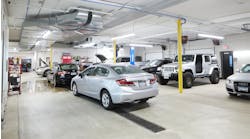Your estimates aren’t that good. It doesn’t matter how many lines, hours or dollars are on your estimates. It doesn’t matter if you spent five minutes or five hours preparing your last estimate. It’s just not that good; and it’s not your fault. The information providers have focused time, money and efforts on advancing user interfaces, parts sourcing solutions and KPI scorecards. These updates have been great and have advanced the collision repair industry. Yet one very important thing has not advanced or been updated much — the estimate itself. Shops rely on estimates to perform multiple duties from aiding in the sales process to providing repair guidance for technicians to billing third-party payers. The estimate is one of the most important documents used in the collision repair industry, yet it hasn’t evolved much over time. Moving forward, estimates will need to become more flexible, more technical and more equitable to continue to move the industry forward.
Estimates are very rigid documents. Information providers vary aesthetically between their print outs, but they are all equally rigid. Visually, estimates have changed very little throughout the years. There have been minor updates to fonts, the addition of colored divider lines, and maybe a spot for a logo or tag line, but that’s it. The estimate remains a cold industrial document with fixed fonts and fixed colors that is just not a very good sales tool. Current estimates lack the ability to convey a repairer’s branding, certifications and messages. Aside from the number of lines on an estimate, to a consumer, the rigidity in estimate formatting makes all repairers appear equal, even when they are not.
But the issue runs deeper than aesthetics. Consumer behaviors have evolved and so, too, must the estimate. Estimate sharing is limited to one file type, the pdf. While this format is easy to send in an email and save to a computer, it poses problems for consumers who have evolved their behaviors. Consumers now read from their cell phones and mobile devices. Websites have evolved from static layouts to reactive designs that match the best user experience to the device’s screen size. Moving estimate sharing away from pdf formatting and into more advanced digital options will yield a better consumer experience and create opportunities in other areas estimates are utilized, as well.
Vehicles and repairs have become increasingly complex, but the estimate has not yet caught up with the needs of the vehicle, technician or consumer. Safe and proper repairs begin by referencing the OEM procedures. OEM procedures lay out a step-by-step plan, complete with torque specs, one-time-use parts warnings and calibration references. These important information pieces remain absent without manual entry onto the estimate. The technicality of the estimate as a technical repair document must evolve to include safety-related information automatically. Inclusion of torque specs, non-reusable parts warnings and calibration notices on line items of estimates will help speed estimate preparation and allow for a more complete and safer repair for the consumer.
Evolution in flexibility and technicality isn’t enough going forward; estimates must become equitable, too. Consumers and technicians represent a myriad of people with differing experiences and different languages. Estimating systems currently only produce estimates in only one or two languages, typically English and Spanish. This creates barriers. Barriers that can prevent a consumer from fully understanding what they are purchasing from a repairer or what the insurance company has estimated on their vehicle. But the barriers continue. Lack of dialect options is a barrier for potential students entering the industry. Lack of dialects is a potential barrier to safe and proper repairs. Treating all consumers and technicians the same by expecting them to read, comprehend and follow an estimate in one or two language options is not equitable. Not in a world that can translate speech between people with cell phones. It is time that our estimates are allowed to speak and speak clearly. Allowing consumers and technicians choice in language options when receiving an estimate is key to ensuring that all parties receive the information they need to succeed.
Evolving the estimate into a functioning, flexible document that will represent a company’s brand, meet the needs of technicians and remove communication barriers for consumers and technicians alike is the right direction to go. It will require information providers to focus on the most basic product they produce. It will require reimagining the estimate. So, while your estimates may not be that good, there is a chance moving forward to make them that much better. It’s time to evolve.




